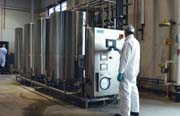CIP system clears bottlenecks for multi-product processor

That was the job confronting the staff at Pacific Foods, Tualatin, Ore., processor of vegetable and dairy-based products for branded retail, private label and institutional markets. With a product line that includes non-dairy soymilk drinks, almond beverages, rice drinks, chai drinks, milk-based beverages, and natural and organic broths, gravies and sauces, streamlining the production flow was an ongoing challenge.
Among the biggest headaches was eliminating bottlenecks caused by the cleaning system. Heavy production demands had pushed the limits of the previous CIP (clean in place) system - so much so that production back-ups had become a daily problem. Often tanker transports, silos, and processing lines all required cleaning at the same time.
To address the problem, Pacific Foods acquired a four-tank Sani-Matic CIP system that has opened clogged arteries across Pacific Foods' 12-building production site. Today, the Sani-Matic system operates 12 to 18 times each day, cleaning the 6,000-gallon transport trailers, 15,000-gallon silos, and the product supply lines.
"We had a clog in our system out in receiving," recalls Ken Habig, the process engineer charged with streamlining the operation. "Tanker transport trucks had to wait for their vessels to be cleaned. This tied up the drivers and sometimes the processing lines."
The pressure on production also jeopardized the quality of the sanitation process. "With the old system, the timer was set for 30 minutes. So the process was done in 30 minutes whether the equipment was clean or not," says Al Johnston, project engineering manager with West Agro, the Kansas City, Mo.-based specialist in cleaning equipment and chemicals Habig called in for assistance.
Cleaning time now runs 25 to 30 minutes for an acid wash on the tankers. For the silos, the CIP program runs 35 to 45 minutes, depending on the product. "The new Sani-Matic CIP system is faster because it maintains temperature and chemical concentration more closely," says Johnston.
Conductivity, temperature and flow are all monitored throughout the CIP cycle. Proper sizing of the heat exchanger minimizes the Sani-Matic's heat-up time. Chemical injection controls minimize the time needed to achieve proper chemical concentrations; they also prevent any chance of over-shooting the concentration set-point. A properly sized sanitizer pump insures cleanliness of lines and tanks. A liquid ring pump assures that process tanks are consistently evacuated. PLC controls are interlocked to the process tanks.
The Sani-Matic recovers final rinse water, re-using it with the caustic and acid solutions for pre-rinse. The result was significant reduction in water and chemical usage. The savings of 300 gallons of fresh water helps cut water use by more than half.
"I felt this process would save a lot of money by not putting as much water out into the waste treatment system," says Habig.
The Sani-Matic CIP equipment has reduced food safety risks while supporting the company's mission of producing wholesome foods that are "close to nature."
For more information:
Steve Ver Keilen, Sani-Matic, Inc., 800-356-3300
steve@sanimatic.com
Looking for a reprint of this article?
From high-res PDFs to custom plaques, order your copy today!








